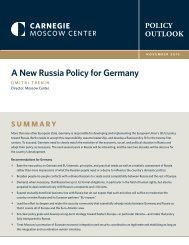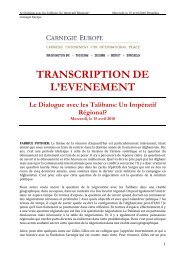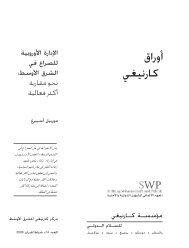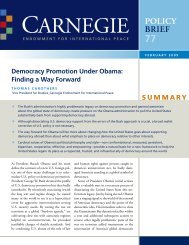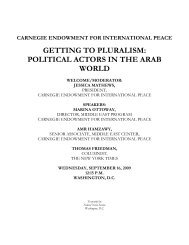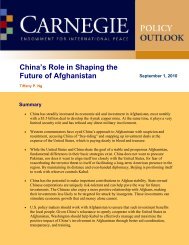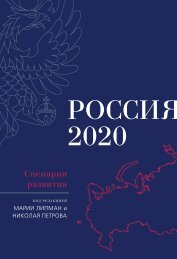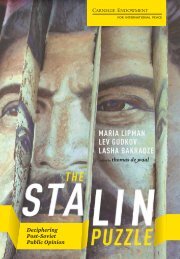The Iranian Nuclear Crisis: A Memoir - Carnegie Endowment for ...
The Iranian Nuclear Crisis: A Memoir - Carnegie Endowment for ...
The Iranian Nuclear Crisis: A Memoir - Carnegie Endowment for ...
Create successful ePaper yourself
Turn your PDF publications into a flip-book with our unique Google optimized e-Paper software.
<strong>The</strong> <strong>Iranian</strong> <strong>Nuclear</strong> <strong>Crisis</strong>: A <strong>Memoir</strong><br />
<strong>The</strong> Book in a Nutshell<br />
Executive Summary<br />
Seyed Hossein Mousavian provides a rare window into Tehran’s internal deliberations in managing the nuclear crisis that began in<br />
2002 with the revelation of covert nuclear activities in Iran. Mousavian draws on extensive research and intimate knowledge <strong>for</strong> a<br />
better understanding of Iran’s nuclear policy. He served as the head of the Foreign Relations Committee of Iran’s Supreme National<br />
Security Council from 1997 to 2005, spokesman <strong>for</strong> Iran’s nuclear negotiating team with the EU and the International Atomic<br />
Energy Agency (IAEA) from 2003 to 2005, and an adviser to Iran’s Supreme National Security Council from 2005 to 2007, be<strong>for</strong>e<br />
being arrested by the Ahmadinejad government and tried <strong>for</strong> treason.<br />
<strong>The</strong> West’s current options <strong>for</strong> dealing with Iran—a preemptive military strike, crippling sanctions, espionage and sabotage, or<br />
learning to live with an <strong>Iranian</strong> bomb—all have serious flaws. Only a comprehensive diplomatic solution can resolve the crisis. To<br />
reach an agreement, the United States and Iran need to better understand each other’s interests and objectives. This book is an<br />
attempt to do precisely that.<br />
Key <strong>The</strong>mes<br />
<strong>The</strong> Origin and Development of Iran’s <strong>Nuclear</strong> Program<br />
(1956–2001): Iran’s nuclear activities far predate the current<br />
crisis and even Iran’s Islamic Republic. Understanding the<br />
history of Iran’s atomic program and the role of the West in<br />
its founding is important <strong>for</strong> any analysis of both the political<br />
and technical disputes today.<br />
<strong>The</strong> First <strong>Crisis</strong> (2002–2003): Initial reports of covert <strong>Iranian</strong><br />
nuclear activity at the Natanz enrichment facility provoked<br />
alarm in the West and a fierce internal debate between<br />
conservatives and re<strong>for</strong>mists within Iran over whether to<br />
cooperate with the international community.<br />
From Tehran to Paris (2003–2004): Negotiations at Sa’dabad<br />
Palace led Iran to temporarily suspend uranium enrichment and<br />
provisionally implement the Additional Protocol, prevented the<br />
country’s nuclear file from being referred to the UN Security<br />
Council, and paved the way <strong>for</strong> cooperation between<br />
Tehran and Brussels. IAEA head Mohamed ElBaradei’s previously<br />
undisclosed definition of what would constitute suspension<br />
of enrichment created expectations in Tehran that then<br />
went unfulfilled, producing lasting confusion and mistrust.<br />
From the Paris Agreement to the 2005 Presidential Election<br />
(2004–2005): Talks with Europe collapsed amid the heat of<br />
Iran’s presidential campaign, as conservatives—led by Mahmoud<br />
Ahmadinejad—attacked moderates <strong>for</strong> compromising with<br />
the West.<br />
<strong>The</strong> Larijani Period (2005–2006): Ahmadinejad’s rise to<br />
power dramatically hardened Iran’s negotiating position.<br />
<strong>The</strong> new president sharply criticized his predecessor’s nuclear<br />
concessions, restarted enrichment, and aggressively sought<br />
confrontation with the West, as well as with <strong>Iranian</strong> political<br />
leaders and diplomats who favored more <strong>for</strong>thcoming<br />
diplomacy. Ali Larijani, the new national security adviser,<br />
turned from the West to the East, hoping that China, Russia,<br />
and India would embrace Iran.<br />
To the Security Council (2006): <strong>The</strong> IAEA dealt a significant<br />
blow to Iran by declaring the country in noncompliance<br />
with its obligations, prompting the UN Security Council to<br />
designate Iran’s nuclear program “a threat to international<br />
peace and security.” Shortly after the Security Council<br />
statement, Ahmadinejad wrote a letter to President<br />
George W. Bush signaling Iran’s readiness <strong>for</strong> bilateral<br />
negotiations and relations with the United States, but<br />
Washington missed the signal.<br />
Back to the Security Council and a New Domestic Situation<br />
(2006–2007): Continued <strong>Iranian</strong> intransigence led the<br />
UN Security Council to impose further sanctions. Faced with<br />
mounting criticism at home, Ahmadinejad began targeting<br />
critics of his nuclear policy, including the author.
Iran Alone—<strong>The</strong> Jalili Period (2007–2008): As the United<br />
States began to engage more directly in negotiations,<br />
inflammatory rhetoric from Ahmadinejad provoked further<br />
UN sanctions and deeper international isolation.<br />
U.S. Engagement (2008–2010): <strong>The</strong> disputed <strong>Iranian</strong> presidential<br />
election and disclosure of the secret Fordow enrichment facility<br />
<strong>for</strong>ced Washington—now backed by a broad international<br />
consensus—to heighten pressure on Tehran.<br />
Recommendations <strong>for</strong> U.S. Policymakers<br />
Negotiate a nuclear package: <strong>The</strong> P5+1 should assure Iran that it will remove the country’s nuclear dossier from the agendas<br />
of the IAEA Board of Governors and the UN Security Council; recognize Iran’s right to nuclear technology, including enrichment;<br />
lift international sanctions; and, as required by the Non-Proliferation Treaty (NPT), cooperate with Iran in the development of<br />
peaceful nuclear technology to the same extent as with other non-nuclear-weapon states. In return, Iran should guarantee a<br />
permanent ban on the development, stockpiling, and use of nuclear weapons based on the fatwa of Iran’s Supreme Leader and<br />
the NPT; establish a consortium with other countries to manage fuel-cycle activities within Iran based on Ahmadinejad’s offer in<br />
September 2005; ratify the Additional Protocol; and commit to cooperate with the IAEA on the removal of all remaining<br />
questions about its past nuclear activities.<br />
Recognize domestic political realities: Tehran is insistent that it be allowed to develop peaceful nuclear energy, just as<br />
Washington is adamant that the Islamic Republic not develop nuclear weapons. Both sides must be realistic, understand the<br />
other’s redlines, and seek a comprehensive diplomatic solution that allows both sides to save face.<br />
Negotiate a U.S.-Iran package: <strong>The</strong>re will be no final resolution of Iran’s nuclear program as long as the bilateral relationship<br />
between Washington and Tehran continues to be dominated by hostilities, threats, and mutual distrust. In parallel with the<br />
nuclear issue, Washington and Tehran should negotiate a bilateral agreement normalizing relations and enhancing cooperation<br />
on issues—including pacifying Afghanistan, stopping the drug trade, opposing al-Qaeda, and limiting the role of the Taliban—<br />
where the two share common interests.<br />
ABOUT THE AUTHOR:<br />
Seyed Hossein Mousavian is a visiting research scholar at Princeton University.<br />
Previously the head of the Foreign Relations Committee of Iran’s Supreme National<br />
Security Council and spokesman <strong>for</strong> Tehran’s nuclear negotiating team, he was<br />
arrested and tried on charges of espionage <strong>for</strong> his opposition to the nuclear and<br />
<strong>for</strong>eign policy of the Ahmadinejad administration.<br />
ABOUT THE CARNEGIE ENDOWMENT FOR INTERNATIONAL PEACE:<br />
Founded in 1910, the <strong>Carnegie</strong> <strong>Endowment</strong> is a leading, nonpartisan think tank<br />
specializing in <strong>for</strong>eign affairs. It is also the world’s first truly global think tank with<br />
operations in Washington, D.C., Moscow, Beijing, Beirut, and Brussels.<br />
<strong>The</strong> <strong>Crisis</strong> Worsens (2010–2012): Multilateral and unilateral<br />
sanctions targeting oil exports and the <strong>Iranian</strong> central bank<br />
have severely harmed Iran’s economy and increased Iran’s<br />
determination to defy the West and continue its nuclear<br />
policy. But Iran still vows not to make nuclear weapons and<br />
to want a diplomatic resolution that reaffirms its rights to the<br />
nuclear fuel cycle while reassuring the world that Iran will not<br />
make nuclear weapons.<br />
FOR MORE INFORMATION:<br />
Additional details are available on the web at: <strong>Carnegie</strong><strong>Endowment</strong>.org/<br />
<strong>Iranian</strong><strong>Nuclear</strong><strong>Crisis</strong>. For more in<strong>for</strong>mation or to speak with one of our scholars,<br />
please do not hesitate to contact our government affairs manager, Scott Toussaint,<br />
at (202) 939-2307 or stoussaint@ceip.org.




